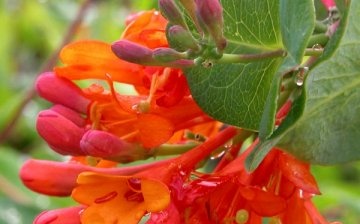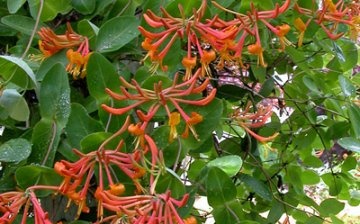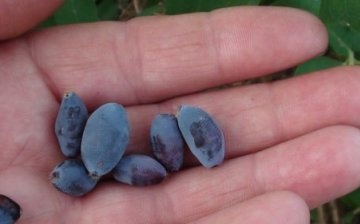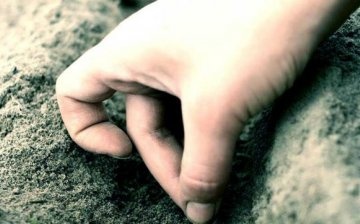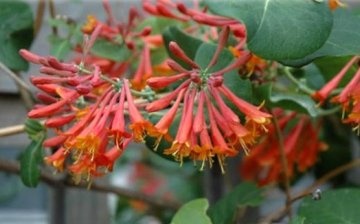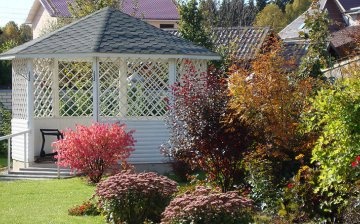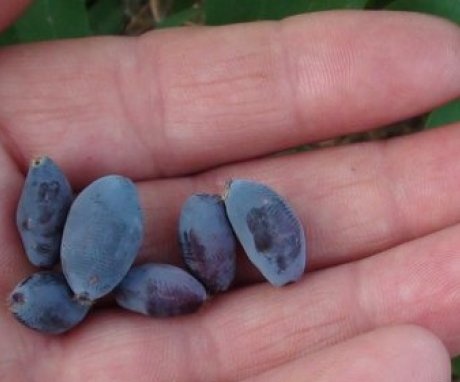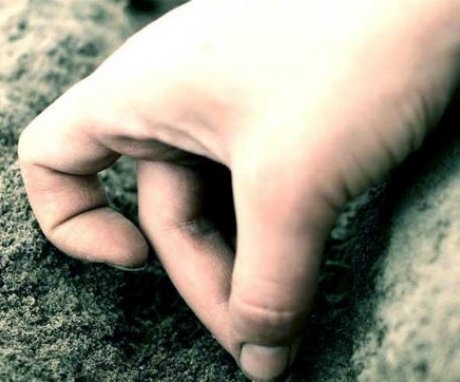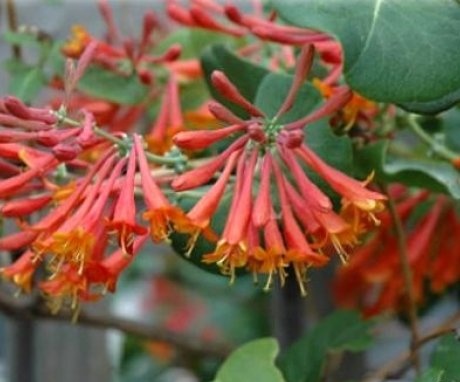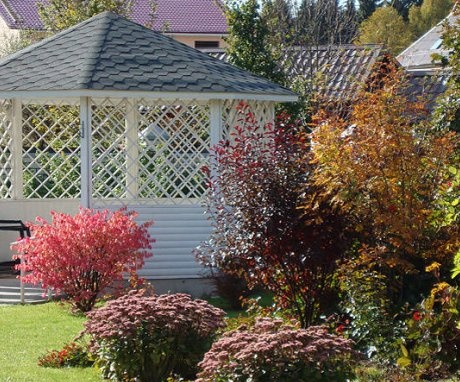Brown's honeysuckle: features of care and cultivation on the site
Honeysuckle is a plant familiar to many gardeners, as it has been used for decorative purposes for a long time. There are many species, but Brown's honeysuckle, which is a semi-evergreen shrub with climbing shoots, has gained particular popularity. It is grown for its dense, beautiful greenery, as well as for its beautiful flowers with a pleasant aroma. It is not difficult to plant honeysuckle, it is a completely unpretentious and patient plant that can withstand various adverse conditions.
Content
- The appearance and features of the shrub
- Growing requirements
- Seed propagation of honeysuckle
- Vegetative propagation of Brown's honeysuckle
- Use of honeysuckle for decorative purposes
The appearance and features of the shrub
Brown's honeysuckle fuchsia is a semi-evergreen shrub, the length of the shoots can reach two to three meters.
This plant is of hybrid origin, as it came from the crossing of rough and evergreen honeysuckle. It got its second name because of special shape of flowersthat slightly resemble fuchsia. Various varieties are known, but in gardens, the Dropmore Scarlet is especially often grown, which has a somewhat unusual appearance.
This variety of honeysuckle:
- The leaves are elliptical, the two leaves grow together to form a single disc.
- The underside has a bluish tint, the top is dark green.
- Flowers can be of different shades, but the most common option is garden honeysuckle with red-orange buds.
- In this case, the very outer part of the flower will be red, and inside it will be bright orange.
- The buds are large, the length of the flowers reaches 5 cm, while they are collected in inflorescences, so the honeysuckle looks very beautiful.
- Bright red-orange buds are noticeable from afar, therefore, columns, gazebos, pergolas and other small architectural forms are decorated with such shrubs when decorating a site.
- It is a perennial plant that can survive even harsh winters with proper care.
It's time for honeysuckle to bloom - from June to October, after the petals fall on the bushes, tough berries ripen.
Brown's honeysuckle fruit is inediblehowever they are used in traditional medicine. Now, when landscaping, it is often varieties that can be grown, the fruits of which can be eaten, which additionally increases their usefulness on the site. Fuchsia honeysuckle has a long flowering period, but it will grow slowly in the first year. A large number of buds can only be expected from the third to fourth year of growth.
Growing requirements
Any ornamental plant needs proper care, only in this case you can get a good result. If you want to grow Brown's honeysuckle on the site, you should know in advance the requirements that this plant has on soil, lighting and other important conditions.
What you need for successful growth:
- Almost all climbing honeysuckle species prefer lighted areas.The sun is necessary both for successful flowering and for the ripening of fruits, so the shoots of the plant will always strive upward. However, Brown's honeysuckle is sensitive to dry soil, so the roots will need to be shaded. Because of this, it is not always easy to find the perfect location.
- Honeysuckle prefers sandy or loamy soil, it should have a neutral or slightly acidic environment. Ideal mixture: turf, peat and sand, proportions should be approximately 3: 1: 1. However, you can plant honeysuckle in ordinary soil, if in the future, fertilizer is applied to it in a timely manner.
- It is important to correctly determine the planting time. Since Brown's honeysuckle has a late growing season, it is recommended to plant it in the spring, when the soil has completely thawed. In any case, a place protected from the cold wind must be chosen for her. Other types of honeysuckle, on the contrary, are more often planted in the fall, and after wintering they begin to give lush shoots.
- You also need to take care of the environment. Honeysuckle is not capable of self-pollination, such plants are called self-fertile. Therefore, it is advisable to plant not one bush next to it, but several. If they are of different varieties, you can subsequently get seeds and grow bushes with new interesting colors.
Thus, in order for honeysuckle to grow, blossom and bear fruit well, it needs to be provided with enough light, protection from the wind, and the right environment. As a reward for her care, she will delight you with lush clusters of bright colors, somewhat reminiscent of small lights.
Honeysuckle can be propagated by seeds or shoots; both methods are actively used in horticulture.
Seed propagation of honeysuckle
A few simple tips on how to grow honeysuckle from seeds:
- It is recommended to extract the seeds from the berries, for which they are thoroughly cleaned of pulp by rubbing the fruits through a sieve.
- This should be done at the end of October, when the berries and seeds in them are fully ripe.
- Before planting, stratification is required - keeping the seeds in a cold atmosphere at a temperature of 0 to 5 degrees.
- This is done to simulate natural conditions, when the seeds are preparing for ripening throughout the winter.
- Stratification increases germination and increases the number of viable shoots.
Sowing is carried out in the spring, when the soil is completely thawed.
- For this, grooves are made into which approximately 3 grams of seeds per meter are placed.
- They do not need to be buried deep, the soil layer above the seeds should not exceed 2 cm.
- Crops sprout very slowly, most often the first young shoots in natural conditions can be expected only by September.
- However, gardeners have developed a method that will speed up germination.
It requires several successive steps:
- Making a mini greenhouse at home. This requires a flat vessel that is covered with glass. Filter paper is laid on it, which easily absorbs water. Water is poured into a vessel, and the ends of the paper strips are dipped into it. Seeds are placed on top of them, and then covered with a layer of thin plastic film.
Water rises up the paper and wets the seeds, while polyethylene prevents heat loss. As a result, the first shoots can be obtained in 3-4 weeks.
- Planting in a seed box. A drainage layer is laid at the bottom of the tank: it can be expanded clay or pebbles, drainage tasks are to prevent water stagnation. On top, soil is poured, consisting of sifted earth, humus (or peat) and sand, a ratio of 3: 1: 1. The surface is leveled, and grooves are drawn along it, the depth of which is about 2 cm. These grooves are well soaked with water, after which paper strips with seeds are transferred to them. The box is covered with glass, periodically watered from a spray bottle.
- Diving into the beds after the appearance of real leaves.At this time, direct sunlight is undesirable, so it is better not to dive in the open sun.
A simple method allows you to accelerate the emergence of seedlings, however, honeysuckle still does not begin to bloom actively until the third year after planting.
Vegetative propagation of Brown's honeysuckle
The vegetative method is also quite common, since it allows you to effectively and quickly propagate the plant, already in the third year after planting, getting a flowering bush, However, you cannot get a new rare color of the buds. Most often, seed propagation is used by breeders, and simple gardeners use vegetative propagation.
For this, spring, summer or winter cuttings, in addition, the division of the bush and reproduction by layering are used:
- Winter cuttings are taken after the fall foliage has fallen off, a part of the stem with several eyes is cut off with a sharp knife, and this is done directly under the eye.
- If it is planned to plant only in the spring, then the cuttings are stored in the basement in a tied form, they are placed in boxes with sand.
- If planting is carried out before winter, then the cuttings placed in the pits are sprinkled with leaves to protect from the cold.
- The cuttings should be approximately 15 cm long.
- In the spring, they are planted immediately after the snow melts; to improve growth, they can be treated with stimulants.
- Indolylbutyric acid is usually used for this purpose.
Honeysuckle propagation can also be carried out with green cuttings; for this, the strongest annual shoots are selected. At the end of the flowering pore with a sharp knife, they are cut into cuttings, the length of which is from 10 to 16 cm. The upper cut of the cutting should be located about 1.5 cm from the leaves, this helps successful growth.
It is not necessary to treat green seed with stimulants as they usually root well on their own.
Freshly planted cuttings should be watered frequently and the ground should be kept slightly moist at all times. The root system will be formed by August, and from next year the plant will begin to shoot especially vigorously. Very soon, it will begin to bloom and bear fruit when properly placed on the site.
Use of honeysuckle for decorative purposes
Brown's honeysuckle is a very beautiful plant that has been used for decorative purposes for a very long time. It is not difficult to grow, and when the bush grows large enough, it can turn into the perfect decoration for the garden.
There are several uses for Brown's honeysuckle in landscape design:
- Hedges... Since they are quite tall shrubs that are very easy to provide good support, honeysuckle can be used to make beautiful bright green hedges with vibrant flowers and ornamental fruits. With its help, you can zone the site, dividing it into separate territories or close yourself from curious neighbors. Dense green leaves adorn any fence, so it is not necessary to build a special hedge.
- Vertical gardening. Honeysuckle stretches towards the light, and it can sit under the window, become an excellent decoration for the facade. However, it is more often used for gazebos and pergolas; with its help, you can skillfully decorate the walls of outbuildings, which themselves will turn into a decorative element in the garden.
- Separate bushes and flower beds. Honeysuckle will look great on its own. A lush bright bush near the porch can become an independent decoration, and it will not go unnoticed. For him, you will need to build a support to which the curly stems will cling.
- Trellis - 2 pillars, between which a grid is placed. On this net, the honeysuckle shoots will rise up, and very soon they will turn into an interesting bright carpet with flowers noticeable from afar. Cut off honeysuckle inflorescences will be a good decoration also indoors.
Brown's Honeysuckle is an easy-to-grow and quite unpretentious plant that can easily find a place and provide excellent flowering.
One look at a flowering bush is enough to boost your mood, and this plant will very quickly become one of the favorite decorations on the site. Plant honeysuckle and you won't regret it.
More information can be found in the video.



